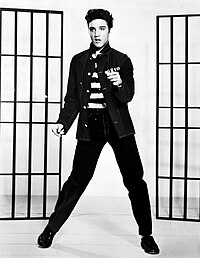Our Miss Brooks
Our Miss Brooks is an American situation comedy starring Eve Arden as a sardonic high school English teacher. It began as a radio show broadcast on CBS from 1948 to 1957. When the show was adapted to television (1952–56), it became one of the medium’s earliest hits.
Our Miss Brooks was considered groundbreaking for showing a woman who was neither a scatter-brained klutz nor a homebody, but rather a working woman who transcended the actual or assumed limits to women’s working lives of the time. Connie Brooks was considered a realistic character in an non-glamorized profession (she often joked, for example, about being underpaid, as many teachers were at the time) who showed women could be competent and self-sufficient outside their home lives without losing their femininity or their humanity. The show ran for 130 episodes on television and won an Emmy award before it was cancelled in 1956.




 In the mid-1950s Elvis Presley became the leading figure of the newly popular sound of Rock-n-Roll.
In the mid-1950s Elvis Presley became the leading figure of the newly popular sound of Rock-n-Roll.
